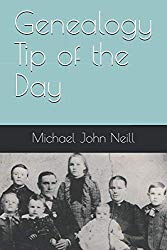When you find a census record, naturalization record, church record, land record, or any record for your ancestor, it’s good to look at records/entries before and after the one you really want. There are several reasons:
- census records–list neighbors–unless they are alphabetical
 tax records–list neighbors–unless they are alphabetical
tax records–list neighbors–unless they are alphabetical- church records–compare the one you want to others to see if it’s “unique” or not and to get clues to reading handwriting if record is not in your native language
- naturalization records–who naturalized on the same day as your ancestor
- land records–people may bring in more than one deed at a time to record
- marriage applications–did another couple go with your ancestor to get a license
- any record–see how the clerk filled out similar records to assist in reading and interpreting the one you really want
Never look at a record in isolation. Those paper neighbors to your ancestor (as I like to call them) can hold clues.

5 Responses
Will remember that tip, You are so helpful.
Thanks!
Be careful when using census records to determine if folks are neighbors. The census taker sometimes changed his route and two households may not be adjacent to each other.
Very true, Kat. Thanks for commenting. I did a follow up on this one.
My husband laughed when I read him this because I have done this for years and have found multiple relatives and connections i didn’t expect at the time. Like another line in same county explaining how they met each other as children. Next door neighbors are freqently siblings, parents or uncles, even grandparents.
Keep a log of family names and write down any you find on those census, etc records, even if they don’t sound familiar. And have a map handy showing county boundries and years they changed name or line.
You’ll be surprised at when they link up later.